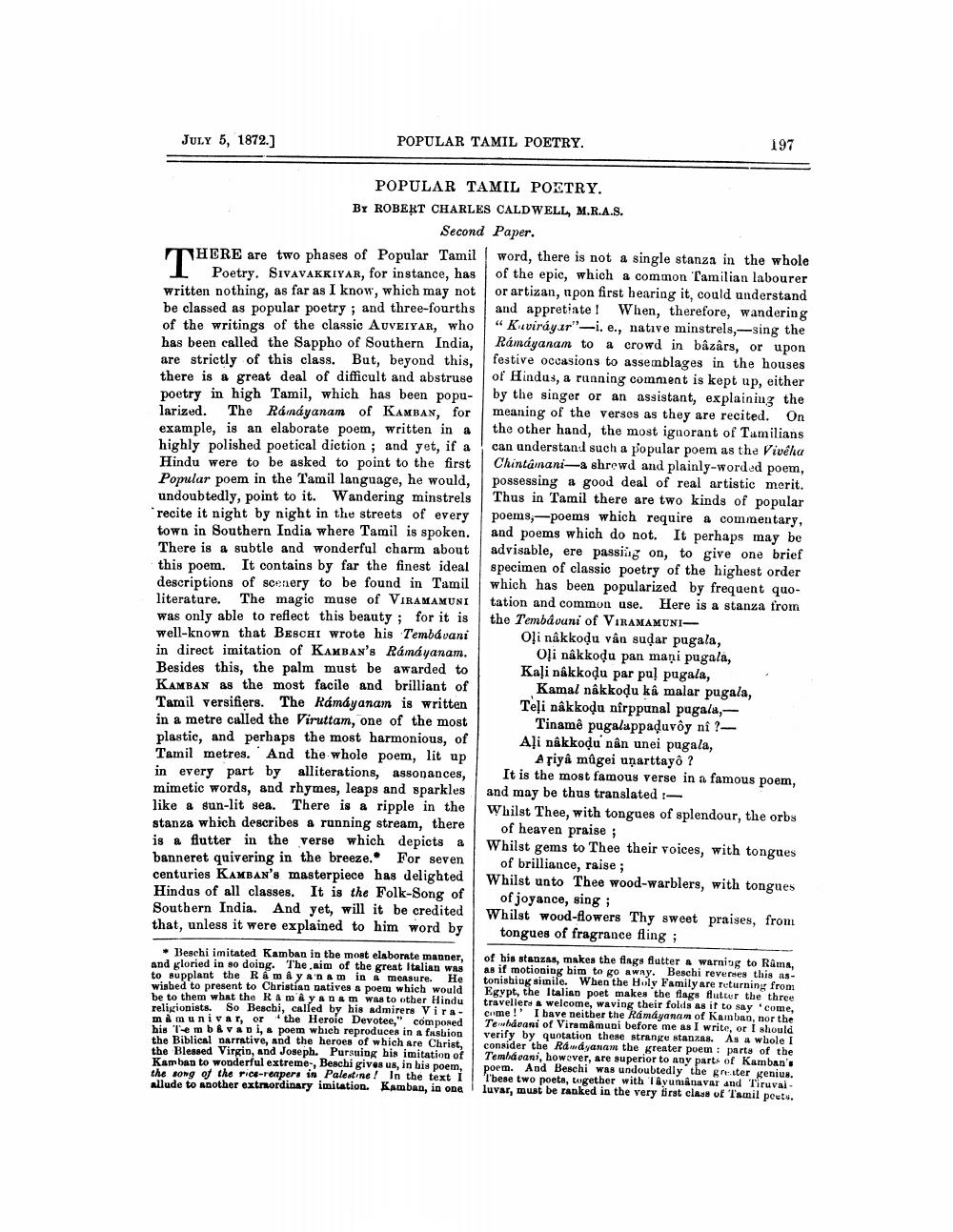________________
JULY 5, 1872.]
POPULAR TAMIL POETRY.
197
POPULAR TAMIL POETRY. BY ROBERT CHARLES CALDWELL, M.R.A.S.
Second Paper. THERE are two phases of Popular Tamil word, there is not a single stanza in the whole
1 Poetry. SIVAVAKKIYAR, for instance, has of the epic, which a common Tamilian labourer written nothing, as far as I know, which may not or artizan, u pon first hearing it could understand be classed as popular poetry; and three-fourths and appretiate! When, therefore, wandering of the writings of the classic AUVEIYAR, who | "Kuviráyur"-i. e., native minstrels, sing the has been called the Sappho of Southern India, Rámáyanam to a crowd in bâzârs, or upon are strictly of this class. But, beyond this, festive occasions to assemblages in the houses there is a great deal of difficult and abstruse of Hindus, a running comment is kept up, either poetry in high Tamil, which has been popu- by the singer or an assistant, explaining the larized. The Ránayanam of KAMBAN, for meaning of the versos as they are recited. On example, is an elaborate poem, written in a the other hand, the most ignorant of Tamilians highly polished poetical diction ; and yet, if a can understand such a popular poem as the Vivéha Hindu were to be asked to point to the first Chintamani-a shrewd and plainly-worded poem, Popular poem in the Tamil language, he would, possessing a good deal of real artistic merit. undoubtedly, point to it. Wandering minstrels Thus in Tamil there are two kinds of popular recite it night by night in the streets of every poems,-poems which require a commentary, town in Southern India where Tamil is spoken. and poems which do not. It perhaps may be There is a subtle and wonderful charm about advisable, ere passiis on. to give one brief this poem. It contains by far the finest ideal specimen of classic poetry of the highest order descriptions of scenery to be found in Tamil which has been popularized by frequent quoliterature. The magic muse of VIRAMAMUNItation and common use. Here is a stanza from was only able to reflect this beauty ; for it is the Tembavuni of VIRAMAMUNIwell-known that Bescht wrote his Tembávani Oļi nâkkodu vân sudar pugala, in direct imitation of KAMBAN's Rámáyanam. Oli nâkkodu pan maņi pugala, Besides this, the palm must be awarded to Kaļi nâkkodu par pul pugala, KAMBAN as the most facile and brilliant of Kamal nâkkodu kâ malar pugala, Tamil versifiers. The Rámáyanam is written Teļi nâkkoda nirppunal pagala, in a metre called the Viruttam, one of the most
Tinamê pugalappaduvoy nî ? - plastic, and perhaps the most harmonious, of Aļi nâkkodu nên unei pugala, Tamil metres. And the whole poem, lit up Asiyâ mûgei uņarttayo ? in every part by alliterations, assonances, It is the most famous verse in a famous poem, mimetic words, and rhymes, leaps and sparkles and may be thus translated :like a sun-lit sea. There is a ripple in the Whilst Thee, with tongues of splendour, the orbs stanza which describes a running stream, there
of heaven praise ; is a flutter in the verse which depicts a Whilst gems to Thee their voices, with tongues banneret quivering in the breeze. For seven
of brilliance, raise ; centuries KAMBAN's masterpiece has delighted Whilst unto Thee wood-warblers, with tongues Hindus of all classes. It is the Folk-Song of of joyance, sing; Southern India. And yet, will it be credited Whilst wood-flowers Thy sweet praises, from that, unless it were explained to him word by
tongues of fragrance fling;
Come!' I have noe, waving their foldshuteur the three
Beschi imitated Kamban in the most elaborate manner. and xloried in so doing. The aim of the great Italian was to supplant the Rim ya'nam in measure. He wisbed to present to Christian datives a poem which would be to them what the Ramayanam was to other Hindu religionists. So Beacbi, called by his admirers Viram A munivar, or the Heroic Devotee," componed his Temb&vani,« poem which reproduces in a fashion the Biblical narrative, and the heroes of which are Christ, the Blessed Virgin, and Joseph. Pursuing bin imitation of Kamban to wonderful extreme, Beachi gives us, in bis poem, the song of the rice-reapers in Palestine! In the text I lude to another extraordinary imitation. Kamban, in one
of his stanzas, makes the flags flutter a warning to Rama, as if motioning him to go away. Beschi reverses this astonishing simile. When the Holy Family are returning from Egypt, the Italian poet makes the flags fluttur the three travellers a welcome, Waving their folds as it to say come. come!' I have neither the Ramayanam of Kamban, nor the Tehdeani of Virama muni before me as I write, or I should verify by quotation these strange stanzas. As a whole I consider the Radyanan the greater poem: parts of the Temhdeani, however, are superior to any parts of Kamban's poem. And Beschi was undoubtedly the Ruster Kenius. 'lbese two poeta, together with Ilyuminavar and Tiruval. luvar, must be ranked in the very first class of Tamil pests.




